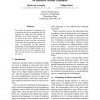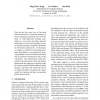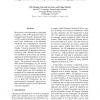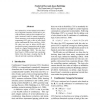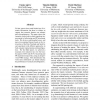ACL
2008
14 years 1 months ago
2008
Previous work on statistical language generation has primarily focused on grammaticality and naturalness, scoring generation possibilities according to a language model or user fe...
ACL
2008
14 years 1 months ago
2008
We address the problem of translating from morphologically poor to morphologically rich languages by adding per-word linguistic information to the source language. We use the synt...
ACL
2007
14 years 1 months ago
2007
Over the last few years, two of the main research directions in machine learning of natural language processing have been the study of semi-supervised learning algorithms as a way...
ACL
2008
14 years 1 months ago
2008
Paraphrase patterns are useful in paraphrase recognition and generation. In this paper, we present a pivot approach for extracting paraphrase patterns from bilingual parallel corp...
ACL
2007
14 years 1 months ago
2007
We propose a novel approach to crosslingual language model (LM) adaptation based on bilingual Latent Semantic Analysis (bLSA). A bLSA model is introduced which enables latent topi...
ACL
2008
14 years 1 months ago
2008
Detecting conflicting statements is a foundational text understanding task with applications in information analysis. We propose an appropriate definition of contradiction for NLP...
ACL
2007
14 years 1 months ago
2007
In this paper, we present a hybrid method for word segmentation and POS tagging. The target languages are those in which word boundaries are ambiguous, such as Chinese and Japanes...
ACL
2008
14 years 1 months ago
2008
The standard set of rules defined in Combinatory Categorial Grammar (CCG) fails to provide satisfactory analyses for a number of syntactic structures found in natural languages. T...
ACL
2007
14 years 1 months ago
2007
Recent research presents conflicting evidence on whether word sense disambiguation (WSD) systems can help to improve the performance of statistical machine translation (MT) syste...
ACL
2008
14 years 1 months ago
2008
To date, parsers have made limited use of semantic information, but there is evidence to suggest that semantic features can enhance parse disambiguation. This paper shows that sem...

